The title of this blog post sounds a little, well, bitchy. In a way, it is meant to sound that way to draw attention and to make the point that we have something to fix.
In too many training processes, we have CFIs and their students trying to get creative with their training. They are trying to shortcut training, combine requirements, and double-dip things to make it so there is less time needed to get things done. Many times this is causing students to end up with missing or mis-qualifying activities toward their required aeronautical experience.
Please stop trying to get overly creative!
That’s it. Don’t get creative and try and mix and match.
The best advice I can give here is simple: “Do what the regulation says.”
Let’s give you some examples of where this goes awry.
How about this as a long private pilot solo qualifying cross-country flight?
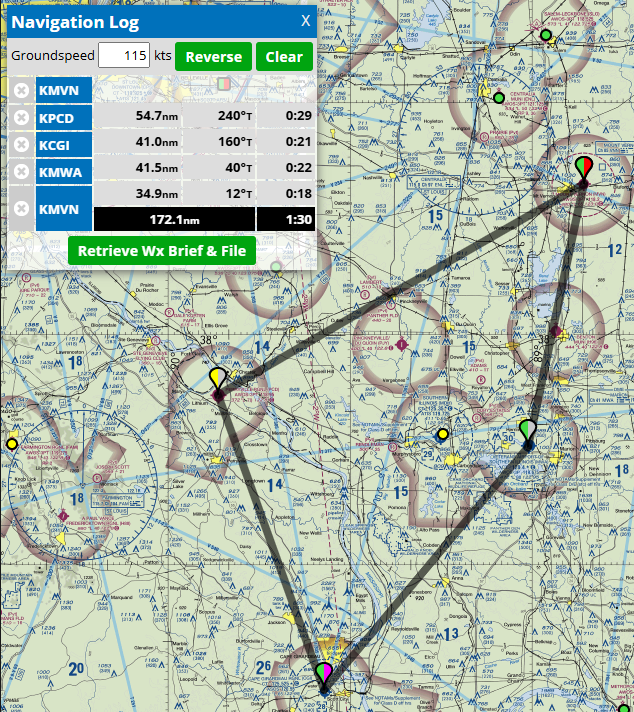
At first look, it might look good. It has more than 150 NM, it has a leg that is longer than 50 NM and a landing point that was more than 50 NM from the original point of origin (14 CFR 61.1 definition). But there is a hiccup here.
The crafty, creative CFI thought it would be a great opportunity for the student to get in some practice at another airport, in this case had the student grab another airport, a 4th one, along the way. They thought that the student doing another landing at Marion (KMWA) would be some good additional experience for them at a towered airport.
They aren’t wrong about that, but in a strict sense, it now means that cross-country solo flight doesn’t count toward the experience requirements for a private pilot certificate.
Huh? You are probably reading this and thinking, “Why?”
Well, words matter. Let’s break it down.
14 CFR 61.106 (a) (5) (iii) indicates that a private pilot candidate needs to complete:

It doesn’t say “at least 3 landings” or “3 or more landings”, it says AT 3. By doing 4 airports in this case (inclusive of the one the student came home to, they didn’t do what the regulation says.
Ok, this is picky. Yup, but it is technical and correct.
That savvy CFI might just then say, Ok, well, then how about I have him “fix his logbook” and that the last leg home was a “different flight” then?
Hmm. Maybe. But how did they endorse the student for that then? Does that match what the student did? or logged?
Plus, this will cause another problem.
If we indulge this possibility, we get the following.
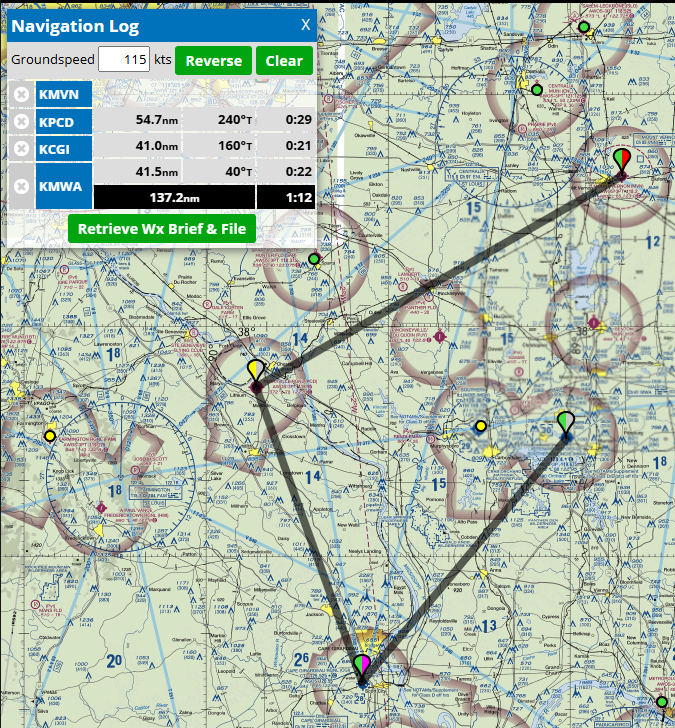
Ha!, see, now its only 3 airports! Yup. But now its less than 150 NM total distance. So, by making that “creative logging” change, you kill the cross country as a qualifying item another way.
Build this carefully, and just do what the regulation says and you won’t end up in this challenge.
What about instrument cross-country requirements?
We have that long IFR cross-country we have to do. Here is an example of one.
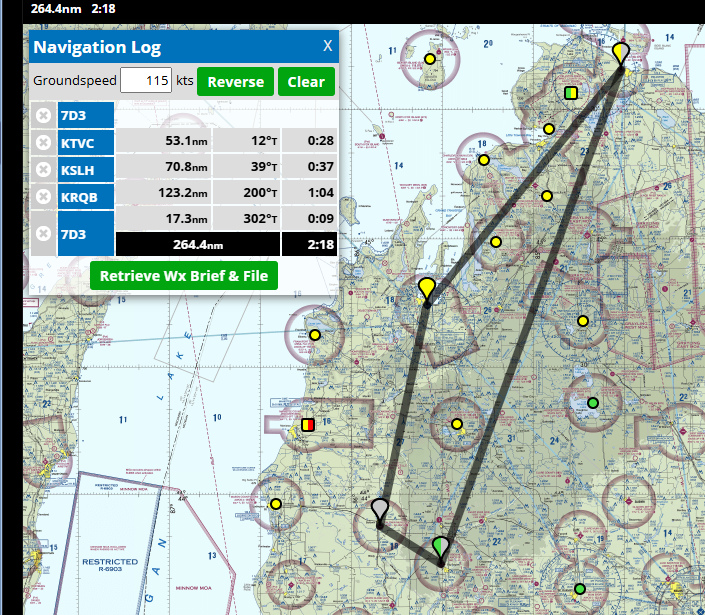
Well, it gets the 250 NM, if we assume they shot approaches at airports they could and did the right mix of those along they way, it looks good on the surface.
The regulation (14 CFR 61.65) says the instrument pilot in training must complete the following:
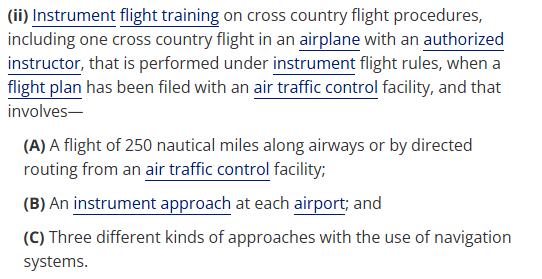
Here are a few ways this could go wrong, and did.
First, the student and CFI didn’t land at KTVC or KSLH but did land at KRQB where they got fuel before coming back to their home airport at 7D3 (which didn’t have fuel). So, while the total distance traveled is over 250 NM, they didn’t land at a location that is over than 50 NM away from the point of origin. KRQB back to 7D3 was only 17.3 NM. This means that the ENTIRE flight doesn’t count as a cross-country flight for use toward a certificate/rating according to the definition in 14 CFR 61.1.
Ok, so that’s a problem. But let’s assume they had landed at KTVC of KSLH, even a full stop taxi-back and then on their way they went. Well, the regulation states that the pilot must have “an instrument approach at EACH airport.”
In this case, the CFI and the pilot flew three approaches, one at KTVC, one at KSLH, and one at KRQB, and then just jumped back to 7D3 VFR, not shooting an approach. I noticed this when I saw 4 airports, and 3 approaches. It got me asking more questions and that’s what I found. That also would nullify meeting the requirement.
Ok, let’s say that they logged that flight separately, the quick VFR leg back home. I think you might see where this is going from the example above, but without that extra 17.3 NM they end up with a total flight distance of 247 miles; short of the required 250. Sigh. A little better planning ahead of this particular event could have avoided these pitfalls.
I have seen this instrument long cross-country flight go wrong lots of ways. Flying out of an airport that doesn’t have an approach and returning to it. Not flying enough total miles, but getting the number of approaches. Failing to land at somewhere more than 50 NM away. All of these can nullify a very expensive flight from counting toward the required experience.
There are LOTS of hiccups in the commercial pilot training experience requirements in 14 CFR 61.129 that people get creative with.
My favorites are when people try to “double dip” a cross-country requirement from their private or instrument training toward their commercial. These are separate regulations. Just because your CFI was with you on a cross-country flight in your instrument rating doesn’t mean that you can use it also toward your dual day or night cross-country experience requirements for your commercial. There are some creative ways to plan ahead, do a fly out somewhere meeting a requirement and back meeting another one, but that takes good planning and some forethought and savvy. Most people mess this up if they to do it ad hoc. If you are planning a full training sequence from student pilot to commercial pilot for a customer you may be able to do this if you lay it out correctly.
If not, again, my best advice is to do what the regulation says in one separate activity to ensure it meets the requirements.
The biggest problem in the commercial we end up finding relates to the solo time requirements. 14 CFR 61.129 (a) (4) [single-engine] and (b) (4) [multi-engine] note that the pilot shall complete:
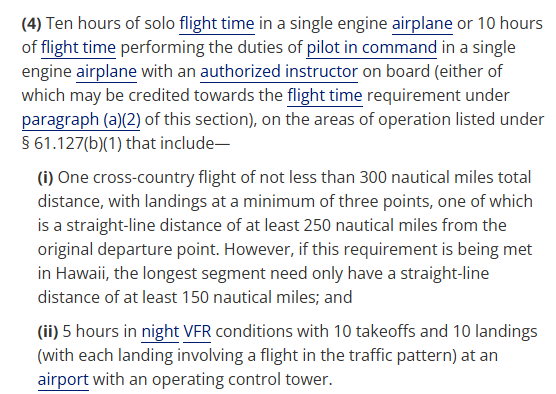
So let’s imagine we wanted to go away from the cold weather in the winter with our plane and do some flight training in Puerto Rico. Sounds good, right?
How about this for a long-commercial-qualifying cross-country flight?

Scenic, beautiful, a total of 315 miles.
Ha, you may be thinking, the regulation says they have to land at 3 places! They landed more than that it kills it, right?!
Well, not in this case. The commercial specifically says “with landings at A MINIMUM OF three points…”This means you can land as many times as you want during this effort. But it does say you have to have a landing point that is more than 250 NM from the point of origin.
Again, language counts.
In this case, KTJBQ (Aguadilla) to the furthest point away, TISX (St. Croix) is only 141 NM. So, you haven’t traveled somewhere physically far enough away from where you started.
We commonly see this messed up for this reason, when people think there has to be a “leg” that is over 250 NM of “in-air” time (that isn’t the case for this one) or even that people think you have to return from the flight! You could go somewhere 251 NM away, fly 50 NM back, park the plane, and never bring it back. I have seen people meet this requirement when they were selling a plane, delivering it, etc. But they did so carefully in their logbooks.
The commercial requirements have to be carefully applied.
Again, you are probably tired of hearing it by now, just do what the regulation says.
There are some more on the commercial and the private that you might want to check out in an older blog post of mine, “Common CFI Checkride “Administrata” Errors” posted in February of 2019. These errors haven’t gone away since I posted this. They keep happening, but we can improve.
How about a couple of others?
In the private pilot, there must be landings at night:

I have seen CFIs do these at “touch and go” landings. That doesn’t count.
The same holds for the requirements for a student in private pilot training at controlled airports practice where they have to complete:

I have watched tower controllers clear students for “the touch and go” and the student either wasn’t instructed to make them full stop landings or was afraid to ask the controller to do so when the controller cleared them otherwise. These little things count.
I could keep offering more of these, but I think you get the point. Get detailed, simplify it, and do what the regulation says. Don’t try to get too crafty. It can burn your student if you don’t get it exactly correct when you try to wedge too many experience requirement satisfying things in one activity.
So, how can you make sure you don’t make these mistakes?
Have a good checklist for each certificate/rating you are training someone for (or if you are receiving training; you can take some control of your training efforts to make sure your CFI is doing it right). There are lots of them out there, there are even some under the Resources tab on this website you can use. I don’t care if you use mine or someone else’s but use something. Don’t just “wing it” (pun intended) and hope that toward the end you can go back into the FARs and review if you have managed to cover everything.
Have a good syllabus, not just things you will cover, but an order in which you will do it. I get it, you might get bored going to the same airports with students over and over, but if you build a sequence that works, covers everything you are supposed to cover, and meets the requirements, it will make sure your students get it done right. Plus it isn’t about you as a CFI. You are supposed to be a professional providing a good training experience. And for them, it will be the first time they have done these things. Think about proper customer service and professional instruction efforts.
Track the student’s progress through the experience requirements, syllabus, and training program. Document it well in case another CFI has to step in and do any of it, or if you as a CFI have to move on to other jobs. Don’t leave your student in a case where people don’t know what experience requirements are done and what ones are left to cover.
When it comes down to it, it is about being a professional. Be a competent CFI who puts the time into planning your student’s training effort to be effective, and efficient, and that it will meet requirements properly.

I disagree with several points but the main point is that the requirements should be fixed, not the training. We need to keep the goal in mind and should not sacrifice good training just to meet the letter of the law. Nor should we make training so expensive and onerous that it becomes cost prohibitive for most. Let’s develop good criteria for experience and good goals of that training. Then we can worry about checking the boxes.